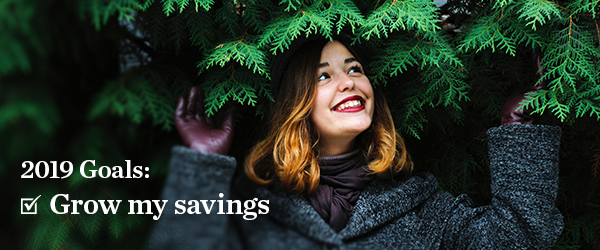Grow Your Cash by Switching to a High-Yield Savings Account

Many or all of the products featured here are from our partners who compensate us. This influences which products we write about and where and how the product appears on a page. However, this does not influence our evaluations. Our opinions are our own. Here is a list of our partners and here's how we make money.
Say hello to 2019! We’re here to help you easily make smart money moves this year so you can save more and spend more time doing the things you love.
The new year is a great time to set those good-for-you resolutions.
It might be hard to find one that sticks (will you still be making daily visits to the gym in March?), but you can do one simple thing right now that's great for your wallet: Move your funds into a better savings account.
Raise your standards
Just because you’ve had the same savings account for a decade doesn’t mean you have to stay loyal to it. Switching only takes a few steps, and you could earn 20 times more by upgrading to a high-yield account. Some banks even offer cash bonuses when you open a new account.
How can you make sure you’re switching to a better account? Compare interest rates and monthly fees, and aim for an account with a higher interest rate and lower (or no) fees. The average annual percentage yield, or APY, for all bank savings accounts is 0.09%.
» MORE: Find the best savings accounts
To help you wrap your head around it, if you were to move $20,000 from an account with a 0.09% APY to one with a 2.05% APY, you could earn almost $400 more by the end of the year. That could buy you a brand new TV — or even a quick weekend getaway.
If you’d like a bank that has branches and ATMs in your city, factor that in as well. But if you don’t need physical branches or in-person customer service, consider online banks. Those tend to offer higher interest rates than brick-and-mortar banks — several offer nearly 2% for deposit accounts — and make it quick and easy to open an account.
Try our calculator see how much more you could earn with different interest rates:
Final steps
Once you transfer funds to your new and improved account, you can close your old account if you’d like. (It’s fine to have multiple bank accounts, but make sure you stay on top of them, especially if you’re paying fees.)
Don't forget to change your direct deposit information, reschedule automatic payments, download your new bank’s mobile app and set up any alerts, as needed.
Then sit back and watch your savings grow while you think about all of your other resolutions.
» MORE: Best savings accounts

Member FDIC
SoFi Checking and Savings

4.60%
$0

Member FDIC
EverBank Performance℠ Savings

5.15%
$0
On a similar note...
Find a better savings account
See NerdWallet's picks for the best high-yield online savings accounts.








